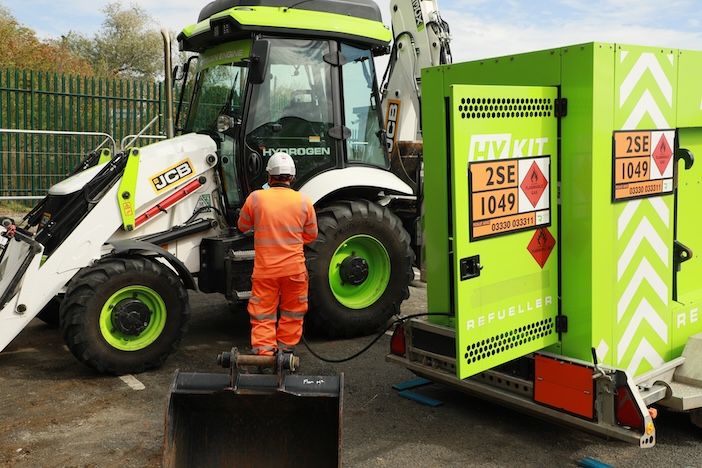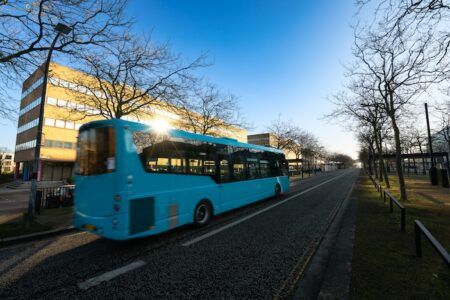A British-made JCB hydrogen fuelled digger – the first one deployed outside a test environment anywhere in the world – has been used to carry out survey work for the Lower Thames Crossing – which will be the first major infrastructure programme in Britain to be carbon neutral in construction, National Highways has confirmed.
The Lower Thames Crossing, a new road and tunnel linking Kent and Essex, will double road capacity across the Thames. It will drive growth by creating a direct and efficient freight route between the ports of the South East, the Midlands, and the North, and easing congestion at the Dartford Crossing – one of the UK’s most vital trade routes that carries a higher percentage of freight than any other road on the strategic road network.
The Lower Thames Crossing is the first in a new generation of British infrastructure projects that is designed to drive economic growth while helping the country to meet its net-zero ambitions and become a clean energy superpower.
As a carbon pathfinder project, the Lower Thames Crossing is scaling up the use of low-carbon construction methods and materials, and in partnership with local SMEs and specialists across Britain is developing new green skills and creating jobs.
The project aims to cut its construction carbon footprint by 70% by aggressively targeting carbon as it refines the design of the new road and adopting new materials and methods of construction as they emerge. It has also made a legal commitment to responsibly offset any remaining carbon emissions using best practice, and only in the early 2030s once efforts to reduce it during construction are exhausted.
Further information on the project’s ambitions can be found in the Lower Thames Crossing’s latest sustainability report that was published today.
The project is making early progress on its promise to carbon neutral as one of its worksites became the first ever to host the live deployment of a hydrogen powered digger anywhere in the world. A British-made JCB digger is being used by Skanska, the project’s delivery partner responsible for building the new road in Kent, to carry out ground investigation surveys around the route of the road near Gravesend. The machine was provided by Flannery Plant Hire, and the hydrogen fuel was provided by Ryze.
The ground investigation work will not only help Skanska refine the detailed design of the road, but has proved that the hydrogen machine is a capable replacement for diesel powered machinery that has already saved over 1 tonne of CO2e during its first four weeks of operation. The live deployment of the machine follows a successful trial at Gallagher’s Hermitage Quarry in Kent earlier this year. The JCB machine is undergoing final testing and validation with plans to go into full production at the firm’s Rocester factory in Staffordshire during 2026.

The project aims to eliminate diesel from its worksites by 2027 by making the largest ever purchase of green hydrogen for a construction project and using it alongside electric and biofuel to power its machinery. The contract to supply, store and distribute hydrogen to the Lower Thames Crossing’s heavy diggers and equipment across its construction sites is expected to be awarded later this year. The project will also only use the lowest carbon concrete and steel.
“The government-backed Lower Thames Crossing will slash journey times for motorists, as well as our vital freight industry. Its construction will also be completely carbon neutral, showing major infrastructure projects can be delivered hand in hand with our ambitious environmental targets,” says Roads and Buses Minister Simon Lightwood. “Built and powered by British businesses, the Lower Thames Crossing is creating economic growth and unlocking jobs, all part of our government’s Plan for Change.”
“Our commitment to being carbon neutral and restoring nature will prove that the British construction industry has the vision and skills to build the projects needed to drive growth in a way that enhances, not impacts, the local environment,” adds Matt Palmer, National Highways Executive Director for Lower Thames Crossing. “It’s an incredibly exciting moment as our ambitions to create a local workforce combine with this cutting-edge technology to put UK construction at the forefront of global innovation.”
The project plans to be the greenest road ever built in the UK by creating six times more green space than road, with a million new trees, a new woodland, two public parks, a wetland for birds and 40 miles of paths for walkers, cyclists and horse riders. Eighty per cent of the road will be in a tunnel, below ground level or behind earthworks and seven new green bridges will create crossing points for wildlife and blend the road into the landscape.
The project received planning permission in March 2025 and is now working with the government on funding options. Construction could start as early as 2026, with the new road expected to open in the early 2030s.





